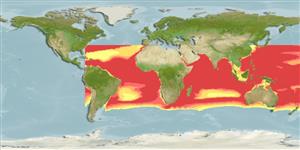>
Myctophiformes (Lanternfishes) >
Myctophidae (Lanternfishes) > Diaphinae
Etymology: Diaphus: Greek, dis, dia = through + Greek, physa, phyo = to beget, to have as offspring (Ref. 45335).
More on authors: Goode & Bean.
Environment: milieu / climate zone / depth range / distribution range
Ökologie
seewasser bathypelagisch; ozeanodrom (Ref. 51243); tiefenbereich 0 - 2999 m (Ref. 58018), usually 200 - ? m (Ref. 4479). Deep-water; 36°N - 49°S, 78°W - 180°E
Eastern Atlantic: disjunct distribution from Morocco-Angola (gap in 17°N-11°N). Western Atlantic: USA to Brazil with isolated specimens to Argentina. Indian Ocean: equatorial waters and west of 70°E to 36°S in Agulhas Current. Indo-west-central Pacific: Southeast Asian seas and north to 8°N and eastwards to 126°W (Ref. 4775). South China Sea (Ref.74511).
Length at first maturity / Size / Gewicht / Alter
Maturity: Lm 9.5, range 9 - 10 cm
Max length : 11.8 cm SL Männchen/unbestimmt; (Ref. 4479)
Rückenflossenstacheln (insgesamt): 0; Rückenflossenweichstrahlen (insgesamt): 16-18; Afterflossenstacheln 0; Afterflossenweichstrahlen: 17 - 19
Oceanic and mesopelagic, found between 425-750 m during the day and between 40-550 m at night (most abundant below 200 m at night) (Ref. 4066, 4775). There is size stratification with depth both day and night (Ref. 4775).
Life cycle and mating behavior
Geschlechtsreife | Fortpflanzung | Ablaichen | Eier | Fecundity | Larven
Hulley, P.A., 1990. Myctophidae. p. 398-467. In J.C. Quero, J.C. Hureau, C. Karrer, A. Post and L. Saldanha (eds.) Check-list of the fishes of the eastern tropical Atlantic (CLOFETA). JNICT, Lisbon; SEI; Paris; and UNESCO, Paris. Vol. 1. (Ref. 4479)
IUCN Rote Liste Status (Ref. 130435)
Bedrohung für Menschen
Harmless
Nutzung durch Menschen
Mehr Information
ReferenzenAquakulturAquakultur ProfilZuchtlinienGenetikElectrophoresesVererbbarkeitKrankheitenVerarbeitungNutrientsMass conversion
PartnerBilderStamps, Coins Misc.LauteCiguateraGeschwindigkeitSchwimmstilKiemenoberflächeOtolithsGehirngrößeSehfähigkeit
Tools
Zusatzinformationen
Download XML
Internet Quellen
Estimates based on models
Preferred temperature (Ref.
123201): 4 - 15.7, mean 7.6 °C (based on 2177 cells).
Phylogenetic diversity index (Ref.
82804): PD
50 = 0.5000 [Uniqueness, from 0.5 = low to 2.0 = high].
Bayesian length-weight: a=0.00741 (0.00433 - 0.01268), b=2.98 (2.83 - 3.13), in cm total length, based on LWR estimates for this species & Genus-body shape (Ref.
93245).
Trophic level (Ref.
69278): 3.0 ±0.00 se; based on food items.
Widerstandsfähigkeit (Ref.
120179): mittel, Verdopplung der Population dauert 1,4 - 4,4 Jahre. (Preliminary K or Fecundity.).
Fishing Vulnerability (Ref.
59153): Low vulnerability (10 of 100).
